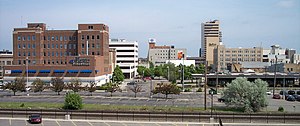Fargo, North Dakota
| Fargo, North Dakota | ||
|---|---|---|
| City | ||

The skyline of downtown Fargo as seen from Main Avenue, facing north.
|
||
|
||
| Motto: Gateway to the West | ||
 Fargo's location in North Dakota |
||
| Location in the United States | ||
| Coordinates: 46°52′38″N 96°47′22″W / 46.87722°N 96.78944°WCoordinates: 46°52′38″N 96°47′22″W / 46.87722°N 96.78944°W | ||
| Country |
|
|
| State |
|
|
| County | Cass | |
| Founded | 1871 | |
| Government | ||
| • Mayor | Tim Mahoney (D) | |
| Area | ||
| • City | 48.82 sq mi (126.44 km2) | |
| • Land | 48.82 sq mi (126.44 km2) | |
| • Water | 0 sq mi (0 km2) | |
| Elevation | 904 ft (274 m) | |
| Population (2010) | ||
| • City | 105,549 | |
| • Estimate (2015) | 118,523 | |
| • Rank | US: 231st | |
| • Density | 2,202.5/sq mi (850.4/km2) | |
| • Urban | 176,676 (US: 194th) | |
| • Metro | 233,836 (US: 192nd) | |
| • Demonym | Fargoan | |
| Time zone | CST (UTC-6) | |
| • Summer (DST) | CDT (UTC-5) | |
| ZIP Codes | 58102-58109, 58121-58122, 58124-58126 | |
| Area code(s) | 701 | |
| FIPS code | 38-25700 | |
| GNIS feature ID | 1028945 | |
| Highways | I-29, I-94, I-94 Bus., US 10, US 52, US 81, US 81 Bus., ND 294 | |
| Website | City of Fargo | |
Fargo is the most populous city in the state of North Dakota, accounting for over 15% of the state population. Fargo is also the county seat of Cass County. According to the 2015 United States Census estimates, its population was 118,523. Fargo, along with its twin city of Moorhead, Minnesota, as well as adjacent West Fargo, North Dakota, and Dilworth, Minnesota. Together these cities form the core of the Fargo-Moorhead, ND-MN Metropolitan Statistical Area, which in 2015 contained a population of 233,836. In 2014, Forbes magazine ranked Fargo as the fourth fastest-growing small city in the United States.
Founded in 1871 and located on the Red River of the North floodplain, Fargo is a cultural, retail, health care, educational, and industrial center for eastern North Dakota and northwestern Minnesota. In addition, Fargo is home to North Dakota State University.
Historically part of Sioux (Dakota) territory, the area that is present-day Fargo was an early stopping point for steamboats traversing the Red River during the 1870s and 1880s. The city was originally named "Centralia," but was later renamed "Fargo" after Northern Pacific Railway director and Wells Fargo Express Company founder William Fargo (1818−1881). The area started to flourish after the arrival of the Northern Pacific Railroad and the city became known as the "Gateway to the West."
...
Wikipedia


